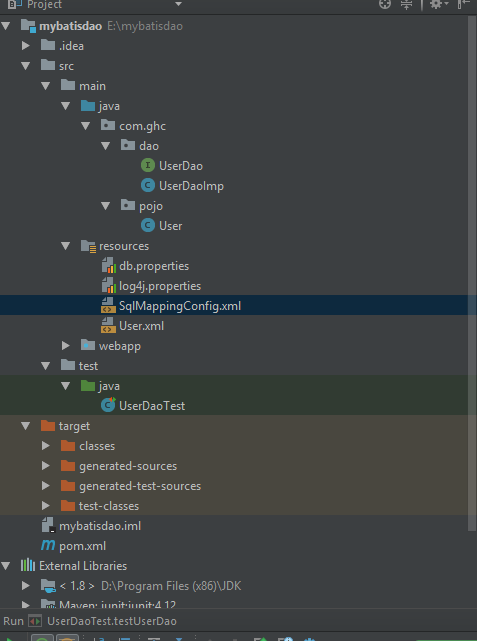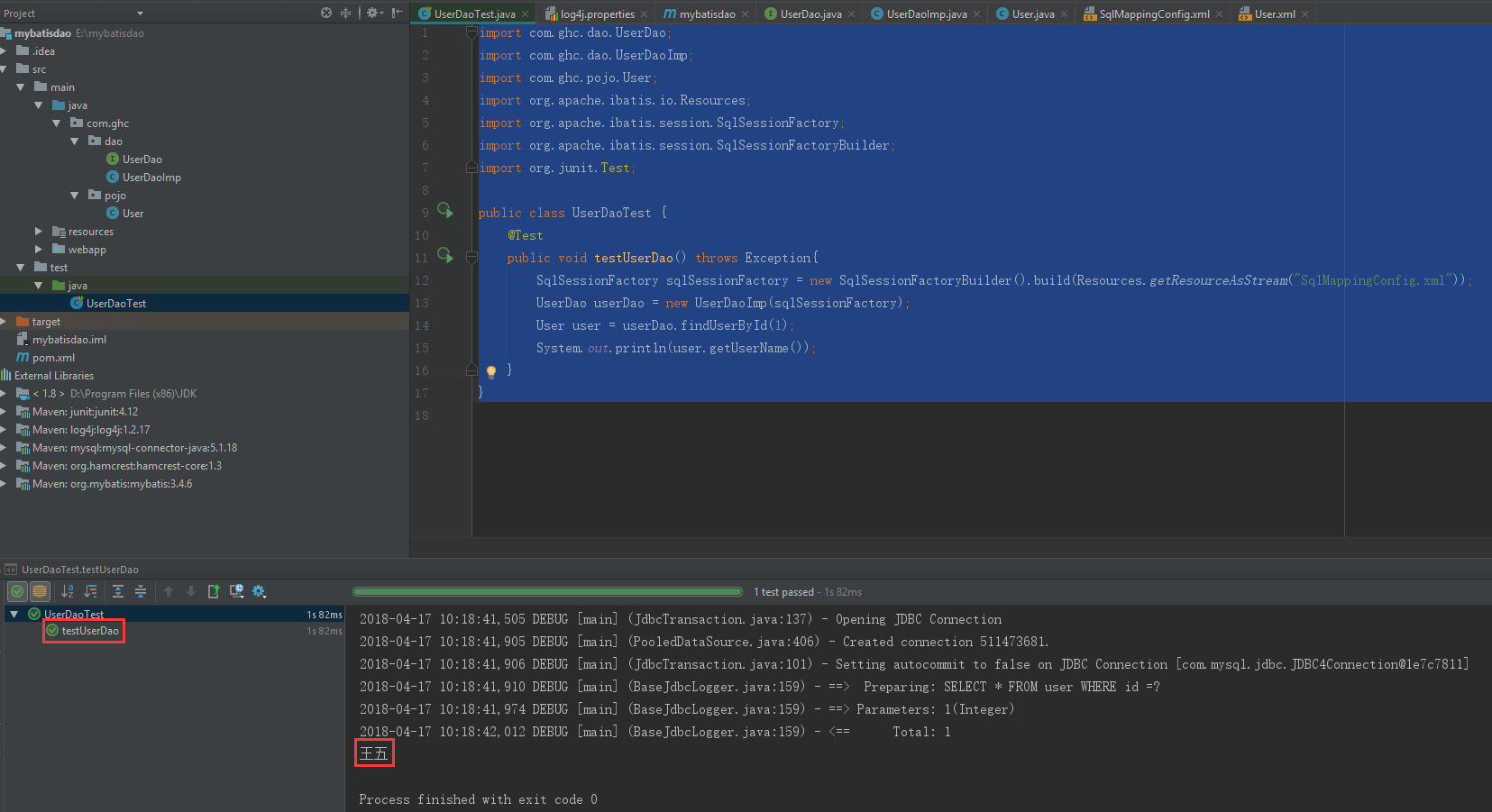mybatis dao 层开发简易版 非整合 spring
同样老习惯,先上项目结构截图

首先 补充上篇文中缺失的 mysql demo 用的 小脚本
drop database if exists mybatis; CREATE DATABASE `mybatis` DEFAULT CHARACTER SET utf8 ; use mybatis;
/*
SQLyog v10.2
MySQL - 5.1.72-community : Database - mybatis
*********************************************************************
*/
/*Table structure for table `items` */ CREATE TABLE `items` (
`id` int(11) NOT NULL AUTO_INCREMENT,
`name` varchar(32) NOT NULL COMMENT '商品名称',
`price` float(10,1) NOT NULL COMMENT '商品定价',
`detail` text COMMENT '商品描述',
`pic` varchar(64) DEFAULT NULL COMMENT '商品图片',
`createtime` datetime NOT NULL COMMENT '生产日期',
PRIMARY KEY (`id`)
) ENGINE=InnoDB AUTO_INCREMENT=4 DEFAULT CHARSET=utf8; /*Table structure for table `user` */ CREATE TABLE `user` (
`id` int(11) NOT NULL AUTO_INCREMENT,
`username` varchar(32) NOT NULL COMMENT '用户名称',
`birthday` date DEFAULT NULL COMMENT '生日',
`sex` char(1) DEFAULT NULL COMMENT '性别',
`address` varchar(256) DEFAULT NULL COMMENT '地址',
PRIMARY KEY (`id`)
) ENGINE=InnoDB AUTO_INCREMENT=27 DEFAULT CHARSET=utf8; /*Table structure for table `orders` */ CREATE TABLE `orders` (
`id` int(11) NOT NULL AUTO_INCREMENT,
`user_id` int(11) NOT NULL COMMENT '下单用户id',
`number` varchar(32) NOT NULL COMMENT '订单号',
`createtime` datetime NOT NULL COMMENT '创建订单时间',
`note` varchar(100) DEFAULT NULL COMMENT '备注',
PRIMARY KEY (`id`),
KEY `FK_orders_1` (`user_id`),
CONSTRAINT `FK_orders_id` FOREIGN KEY (`user_id`) REFERENCES `user` (`id`) ON DELETE NO ACTION ON UPDATE NO ACTION
) ENGINE=InnoDB AUTO_INCREMENT=6 DEFAULT CHARSET=utf8; /*Table structure for table `orderdetail` */ CREATE TABLE `orderdetail` (
`id` int(11) NOT NULL AUTO_INCREMENT,
`orders_id` int(11) NOT NULL COMMENT '订单id',
`items_id` int(11) NOT NULL COMMENT '商品id',
`items_num` int(11) DEFAULT NULL COMMENT '商品购买数量',
PRIMARY KEY (`id`),
KEY `FK_orderdetail_1` (`orders_id`),
KEY `FK_orderdetail_2` (`items_id`),
CONSTRAINT `FK_orderdetail_1` FOREIGN KEY (`orders_id`) REFERENCES `orders` (`id`) ON DELETE NO ACTION ON UPDATE NO ACTION,
CONSTRAINT `FK_orderdetail_2` FOREIGN KEY (`items_id`) REFERENCES `items` (`id`) ON DELETE NO ACTION ON UPDATE NO ACTION
) ENGINE=InnoDB AUTO_INCREMENT=5 DEFAULT CHARSET=utf8;
mysql 数据库及表结构
/*
SQLyog v10.2
MySQL - 5.1.72-community : Database - mybatis
*********************************************************************
*/
/*Data for the table `items` */ insert into `items`(`id`,`name`,`price`,`detail`,`pic`,`createtime`) values (1,'台式机',3000.0,'该电脑质量非常好!!!!',NULL,'2016-02-03 13:22:53'),(2,'笔记本',6000.0,'笔记本性能好,质量好!!!!!',NULL,'2015-02-09 13:22:57'),(3,'背包',200.0,'名牌背包,容量大质量好!!!!',NULL,'2016-02-06 13:23:02'); /*Data for the table `user` */ insert into `user`(`id`,`username`,`birthday`,`sex`,`address`) values (1,'王五',NULL,'',NULL),(10,'张三','2016-07-10','','北京市'),(16,'张小明',NULL,'','河南郑州'),(22,'陈小明',NULL,'','河南郑州'),(24,'张三丰',NULL,'','河南郑州'),(25,'陈小明',NULL,'','河南郑州'),(26,'王五',NULL,NULL,NULL); /*Data for the table `orders` */ insert into `orders`(`id`,`user_id`,`number`,`createtime`,`note`) values (3,1,'','2016-02-04 13:22:35',NULL),(4,1,'','2016-02-03 13:22:41',NULL),(5,10,'','2016-02-12 16:13:23',NULL); /*Data for the table `orderdetail` */ insert into `orderdetail`(`id`,`orders_id`,`items_id`,`items_num`) values (1,3,1,1),(2,3,2,3),(3,4,3,4),(4,4,2,3);
mysql 插入测试数据脚本
工程采用 maven 管理,pom.xml 内容如下
<?xml version="1.0" encoding="UTF-8"?> <project xmlns="http://maven.apache.org/POM/4.0.0" xmlns:xsi="http://www.w3.org/2001/XMLSchema-instance"
xsi:schemaLocation="http://maven.apache.org/POM/4.0.0 http://maven.apache.org/xsd/maven-4.0.0.xsd">
<modelVersion>4.0.0</modelVersion> <groupId>com.ghc</groupId>
<artifactId>mybatisdao</artifactId>
<version>1.0-SNAPSHOT</version>
<packaging>war</packaging> <name>mybatisdao Maven Webapp</name>
<!-- FIXME change it to the project's website -->
<url>http://www.example.com</url> <properties>
<project.build.sourceEncoding>UTF-8</project.build.sourceEncoding>
<maven.compiler.source>1.7</maven.compiler.source>
<maven.compiler.target>1.7</maven.compiler.target>
</properties> <dependencies>
<!-- https://mvnrepository.com/artifact/junit/junit -->
<dependency>
<groupId>junit</groupId>
<artifactId>junit</artifactId>
<version>4.12</version>
<scope>test</scope>
</dependency> <!-- https://mvnrepository.com/artifact/org.mybatis/mybatis -->
<dependency>
<groupId>org.mybatis</groupId>
<artifactId>mybatis</artifactId>
<version>3.4.6</version>
</dependency> <!-- https://mvnrepository.com/artifact/log4j/log4j -->
<dependency>
<groupId>log4j</groupId>
<artifactId>log4j</artifactId>
<version>1.2.17</version>
</dependency> <!-- https://mvnrepository.com/artifact/mysql/mysql-connector-java -->
<dependency>
<groupId>mysql</groupId>
<artifactId>mysql-connector-java</artifactId>
<version>5.1.18</version>
</dependency> </dependencies> <build>
<finalName>mybatisdao</finalName>
<pluginManagement><!-- lock down plugins versions to avoid using Maven defaults (may be moved to parent pom) -->
<plugins>
<plugin>
<artifactId>maven-clean-plugin</artifactId>
<version>3.0.0</version>
</plugin>
<!-- see http://maven.apache.org/ref/current/maven-core/default-bindings.html#Plugin_bindings_for_war_packaging -->
<plugin>
<artifactId>maven-resources-plugin</artifactId>
<version>3.0.2</version>
</plugin>
<plugin>
<artifactId>maven-compiler-plugin</artifactId>
<version>3.7.0</version>
</plugin>
<plugin>
<artifactId>maven-surefire-plugin</artifactId>
<version>2.20.1</version>
</plugin>
<plugin>
<artifactId>maven-war-plugin</artifactId>
<version>3.2.0</version>
</plugin>
<plugin>
<artifactId>maven-install-plugin</artifactId>
<version>2.5.2</version>
</plugin>
<plugin>
<artifactId>maven-deploy-plugin</artifactId>
<version>2.8.2</version>
</plugin>
</plugins>
</pluginManagement>
</build>
</project>
pom.xml
接下来就是 四个 配置文件了, 其中 db.properties 里的 key 到 SqlMappingConfig.xml 里就引用不到,这点作为初学者也觉得无奈,暂且就硬编码吧

jdbc.driver=com.mysql.jdbc.Driver
jdbc.url=jdbc:mysql://localhost:3306/mybatis?characterEncoding=UTF-8
jdbc.username=root
jdbc.password=Mede645
db.properties 引用不到显得可有可无
log4j.rootLogger=DEBUG,A1
log4j.logger.org.springframework=debug
log4j.appender.A1=org.apache.log4j.ConsoleAppender
log4j.appender.A1.layout=org.apache.log4j.PatternLayout
log4j.appender.A1.layout.ConversionPattern=%d %5p [%t] (%F:%L) - %m%n
log4j.properties 不用重点关注
<?xml version="1.0" encoding="UTF-8" ?>
<!DOCTYPE configuration
PUBLIC "-//mybatis.org//DTD Config 3.0//EN"
"http://mybatis.org/dtd/mybatis-3-config.dtd">
<configuration> <!-- 加载属性文件 -->
<properties resource="db.properties">
<!--properties中还可以配置一些属性名和属性值 -->
<!-- <property name="jdbc.driver" value=""/> -->
</properties> <typeAliases> <typeAlias type="com.ghc.pojo.User" alias="user" /> </typeAliases> <!-- 和spring整合后 environments配置将废除 -->
<environments default="development">
<environment id="development">
<!-- 使用jdbc事务管理,事务控制由mybatis -->
<transactionManager type="JDBC" />
<!-- 数据库连接池,由mybatis管理 -->
<dataSource type="POOLED">
<property name="driver" value="com.mysql.jdbc.Driver" />
<property name="url" value="jdbc:mysql://localhost:3306/mybatis?characterEncoding=UTF-8" />
<property name="username" value="root" />
<property name="password" value="Mede645" />
</dataSource>
</environment>
</environments> <mappers>
<mapper resource="User.xml"/>
</mappers> </configuration>
SqlMappingConfig.xml 很重要很重要
<?xml version="1.0" encoding="UTF-8" ?>
<!DOCTYPE mapper
PUBLIC "-//mybatis.org//DTD Mapper 3.0//EN"
"http://mybatis.org/dtd/mybatis-3-mapper.dtd"> <mapper namespace="com.ghc.dao.UserDao">
<select id="findUserById" parameterType="java.lang.Integer" resultType="user">
SELECT * FROM user WHERE id =#{userid} <!--简单类型 随意取名-->
</select> </mapper>
User.xml 这个配置文件也比较重要
<select id="findUserLike" parameterType="java.lang.String" resultType="user">
SELECT * FROM user WHERE username LIKE '%${value}%'
</select>
<insert id="addUser" parameterType="user">
INSERT INTO user(username,birthday,sex,address) values(#{userName},#{birthday},#{sex},#{address})
</insert>
<delete id="deleteUserById" parameterType="int">
DELETE FROM user WHERE id=#{id}
</delete>
<update id="updateUserById" parameterType="user">
UPDATE user set username=#{userName},birthday= #{birthday},sex=#{sex},address=#{address} WHERE id = #{id}
</update> 上面是新增的 部分,下面请拷贝如有需要 <?xml version="1.0" encoding="UTF-8" ?>
<!DOCTYPE mapper
PUBLIC "-//mybatis.org//DTD Mapper 3.0//EN"
"http://mybatis.org/dtd/mybatis-3-mapper.dtd"> <mapper namespace="com.ghc.dao.UserDao">
<select id="findUserById" parameterType="java.lang.Integer" resultType="user">
SELECT * FROM user WHERE id =#{userid} <!--简单类型 随意取名-->
</select> <select id="findUserLike" parameterType="java.lang.String" resultType="user">
SELECT * FROM user WHERE username LIKE '%${value}%'
</select>
<insert id="addUser" parameterType="user">
INSERT INTO user(username,birthday,sex,address) values(#{userName},#{birthday},#{sex},#{address})
</insert>
<delete id="deleteUserById" parameterType="int">
DELETE FROM user WHERE id=#{id}
</delete>
<update id="updateUserById" parameterType="user">
UPDATE user set username=#{userName},birthday= #{birthday},sex=#{sex},address=#{address} WHERE id = #{id}
</update>
</mapper>
修改后的 User.xml
与持久层映射的 pojo 对象 , 就是 简单java 对象的意思,没事儿别整高大上,故作高深。。。。
package com.ghc.pojo;
import java.util.Date;
public class User {
private int id;
private String userName;
private Date birthday;
private String sex;
private String address;
public int getId() {
return id;
}
public void setId(int id) {
this.id = id;
}
public String getUserName() {
return userName;
}
public void setUserName(String userName) {
this.userName = userName;
}
public Date getBirthday() {
return birthday;
}
public void setBirthday(Date birthday) {
this.birthday = birthday;
}
public String getSex() {
return sex;
}
public void setSex(String sex) {
this.sex = sex;
}
public String getAddress() {
return address;
}
public void setAddress(String address) {
this.address = address;
}
}
com.ghc.pojo.User
第一种方法采用 原始 dao 开发方法即先写 dao 接口,再写其实现类
package com.ghc.dao;
import com.ghc.pojo.User;
public interface UserDao{
public User findUserById(int id) throws Exception;
}
com.ghc.dao.UserDao 接口
package com.ghc.dao; import com.ghc.pojo.User;
import org.apache.ibatis.jdbc.SQL;
import org.apache.ibatis.session.SqlSessionFactory; import java.io.IOException; public class UserDaoImp implements UserDao {
// 由于没有整合,这里无法使用spring容器自动注入,手动采取构造函数注入
// SqlSessionFactoryBuilder 看做工具类,而 SqlSessionFactor 做成单例
//private SqlSessionFactoryBuilder sqlSessionFactoryBuilder = new SqlSessionFactoryBuilder();
private SqlSessionFactory sqlSessionFactory;
public UserDaoImp(SqlSessionFactory sqlSessionFactory){
this.sqlSessionFactory = sqlSessionFactory;
}
@Override
public User findUserById(int id) throws IOException {
return sqlSessionFactory.openSession().selectOne("com.ghc.dao.UserDao.findUserById",id);
}
}
com.ghc.UserDaoImp 接口实现类
package com.ghc.dao;
import com.ghc.pojo.User; import java.util.List; public interface UserDao{
User findUserById(int id) throws Exception;
List<User> findUserLike(String userName) throws Exception;
void addUser(User user) throws Exception;
void deleteUserById(int id) throws Exception;
void updateUserById(User user) throws Exception;
}
添加新功能的dao层接口
package com.ghc.dao; import com.ghc.pojo.User;
import org.apache.ibatis.jdbc.SQL;
import org.apache.ibatis.session.SqlSession;
import org.apache.ibatis.session.SqlSessionFactory; import java.io.IOException;
import java.util.List; public class UserDaoImp implements UserDao {
// 由于没有整合,这里无法使用spring容器自动注入,手动采取构造函数注入
// SqlSessionFactoryBuilder 看做工具类,而 SqlSessionFactor 做成单例
//private SqlSessionFactoryBuilder sqlSessionFactoryBuilder = new SqlSessionFactoryBuilder();
private SqlSessionFactory sqlSessionFactory;
public UserDaoImp(SqlSessionFactory sqlSessionFactory){
this.sqlSessionFactory = sqlSessionFactory;
}
@Override
public User findUserById(int id) throws IOException {
return sqlSessionFactory.openSession().selectOne("com.ghc.dao.UserDao.findUserById",id);
} @Override
public List<User> findUserLike(String userName) throws Exception {
return sqlSessionFactory.openSession().selectList("com.ghc.dao.UserDao.findUserLike",userName);
} @Override
public void addUser(User user) throws Exception {
SqlSession sqlSession = sqlSessionFactory.openSession();
sqlSession.insert("com.ghc.dao.UserDao.addUser",user);
sqlSession.commit();
} @Override
public void deleteUserById(int id) throws Exception {
SqlSession sqlSession = sqlSessionFactory.openSession();
sqlSession.delete("com.ghc.dao.UserDao.deleteUserById",id );
sqlSession.commit();
} @Override
public void updateUserById(User user) throws Exception {
SqlSession sqlSession= sqlSessionFactory.openSession();
sqlSession.update("com.ghc.dao.UserDao.updateUserById",user);
sqlSession.commit();
} }
添加新功能后的dao层实现类
既然第一个 UserDao 开发好了,我们就可以直接拿来测试一波了
import com.ghc.dao.UserDao;
import com.ghc.dao.UserDaoImp;
import com.ghc.pojo.User;
import org.apache.ibatis.io.Resources;
import org.apache.ibatis.session.SqlSessionFactory;
import org.apache.ibatis.session.SqlSessionFactoryBuilder;
import org.junit.Test; public class UserDaoTest {
@Test
public void testUserDao() throws Exception{
SqlSessionFactory sqlSessionFactory = new SqlSessionFactoryBuilder().build(Resources.getResourceAsStream("SqlMappingConfig.xml"));
UserDao userDao = new UserDaoImp(sqlSessionFactory);
User user = userDao.findUserById(1);
System.out.println(user.getUserName());
}
}
junit测试一波咯
import com.ghc.dao.UserDao;
import com.ghc.dao.UserDaoImp;
import com.ghc.pojo.User;
import org.apache.ibatis.io.Resources;
import org.apache.ibatis.session.SqlSessionFactory;
import org.apache.ibatis.session.SqlSessionFactoryBuilder;
import org.junit.Test; import java.util.List;
import java.util.Date; public class UserDaoTest {
@Test
public void testUserDao() throws Exception{
SqlSessionFactory sqlSessionFactory = new SqlSessionFactoryBuilder().build(Resources.getResourceAsStream("SqlMappingConfig.xml"));
UserDao userDao = new UserDaoImp(sqlSessionFactory);
User user = userDao.findUserById(1);
System.out.println(user.getUserName());
List<User> userList = userDao.findUserLike("小明");
for(User u:userList){
System.out.println(u.getUserName());
} User user1 = new User();
user1.setUserName("孔方兄");
user1.setSex("某");
user1.setBirthday(new Date());
user1.setAddress("麓谷");
userDao.addUser(user1); // userDao.deleteUserById(1); 因为主外键的问题所以暂注释掉 // update 方法
User user2 = new User();
user2.setId(43);
user2.setUserName("黑钻石王老五");
user2.setBirthday(new Date());
user2.setSex("南");
user2.setAddress("北京天安门");
userDao.updateUserById(user2);
}
}
添加新功能后的测试文件
测试结果:

待续 第二种 只写接口方法。。。
mybatis dao 层开发简易版 非整合 spring的更多相关文章
- 基于Mybatis的Dao层开发
转自:https://www.cnblogs.com/rodge-run/p/6528398.html 基于Mybatis的Dao层开发 SqlSessionFactoryBuilder用于创建 Sq ...
- SSM框架之Mybatis(3)dao层开发
Mybatis(3)dao层开发 以实现类完成CRUD操作 1.持久层dao层接口的书写 src\main\java\dao\IUserDao.java package dao; import dom ...
- Spring Boot 2.X(二):集成 MyBatis 数据层开发
MyBatis 简介 概述 MyBatis 是一款优秀的持久层框架,支持定制化 SQL.存储过程以及高级映射.它采用面向对象编程的方式对数据库进行 CRUD 的操作,使程序中对关系数据库的操作更方便简 ...
- MyBatis dao层 方法传参
MyBatis dao层 方法传参有三种方法. 1. 以下标的方法获取参数. <update id="insertSuccessKilled"> INSER ...
- C#调用OpenCV开发简易版美图工具
前言 在C#调用OpenCV其实非常简单,因为C#中有很多OPenCV的开源类库. 本文主要介绍在WPF项目中使用OpenCVSharp3-AnyCPU开源类库处理图片,下面我们先来做开发前的准备工作 ...
- MyBatis Dao层的编写
传统的dao层编写 以前编写dao层,先新建一个包com.chy.dao,再写接口StudentDao: public interface StudentDao { public void inser ...
- (转)MyBatis框架的学习(三)——Dao层开发方法
http://blog.csdn.net/yerenyuan_pku/article/details/71700957 使用MyBatis开发Dao层,通常有两个方法,即原始Dao开发方法和Mappe ...
- MyBatis开发Dao层的两种方式(原始Dao层开发)
本文将介绍使用框架mybatis开发原始Dao层来对一个对数据库进行增删改查的案例. Mapper动态代理开发Dao层请阅读我的下一篇博客:MyBatis开发Dao层的两种方式(Mapper动态代理方 ...
- 02.MyBatis在DAO层开发使用的Mapper动态代理方式
在实际开发中,Mybatis作用于DAO层,那么Service层该如何调用Mybatis Mybatis鼓励使用Mapper动态代理的方式 Mapper接口开发方法只需要程序员编写Mapper接口(相 ...
随机推荐
- Altium CAED 国际认证操作题例题(含下载)
官网介绍页面 https://www.altium.com.cn/certification 共五套操作题 含资料 蓝奏云:https://www.lanzous.com/i2lj1ng 百度网盘:h ...
- 激活IntelliJ IDEA到2100年
1.下载破解文件(破解版本2018.2,其他版本未尝试) http://idea.lanyus.com/jar/JetbrainsIdesCrack-4.2-release-sha1-3323d5d0 ...
- 一款基于Zigbee技术的智慧鱼塘系统研究与设计
在现代鱼塘养鱼中,主要困扰渔农的就是养殖成本问题.而鱼塘养殖成本最高的就是养殖的人工费,喂养的饲料费和鱼塘中高达几千瓦增氧机的消耗的电费.实现鱼塘自动化养殖将会很好地解决上述问题,大大提高渔农的经济效 ...
- Python对Selenium调用浏览器进行封装包括启用无头浏览器,及对应的浏览器配置文件
""" 获取浏览器 打开本地浏览器 打开远程浏览器 关闭浏览器 打开网址 最大化 最小化 标题 url 刷新 Python对Selenium封装浏览器调用 ------b ...
- idea使用actiBPM插件中文乱码
idea 安转activiti插件后,编辑流程图发现保存后中文乱码,并且idea的字符集(Settings—>Editor—>File Encodings)已经设置为UTF-8,流程图中中 ...
- Unity XLua 官方教程学习
一.Lua 文件加载 1. 执行字符串 using UnityEngine; using XLua; public class ByString : MonoBehaviour { LuaEnv lu ...
- python获取时间————前一天后一天前一小时后一小时前一分钟后一分钟
获取当天日期 一: import time print(time.strftime("%Y-%m-%d")) #输出当前日期 2018-05-01 二: import dateti ...
- C# 词频统计 东北师范大学 软件项目管理 第一次作业
一.作为杨老师的学生第一次听杨老师讲课,印象最深的就是:工程中所有步骤之间是乘法,如果任何一步为0,工程就做不出来了.以前所有老师讲到的都是不要太在乎结果,努力的过程很重要,但是这在软件工程中不合适了 ...
- Notes of Daily Scrum Meeting(12.19)
今天工作进展的速度别昨天稍有提高,希望大家再接再厉!加油! 团队任务总结如下: 团队成员 今日团队工作 陈少杰 重新尝试使用get等方法进行网络连接的调试 王迪 调试搜索功能中测出的问题 金鑫 测试已 ...
- mysql 访问不是本地数据库,给用户刷新了权限没有作用
1.grant all privileges on *.* to 'yangxin'@'%' identified by 'yangxin123456' with grant option; flus ...
